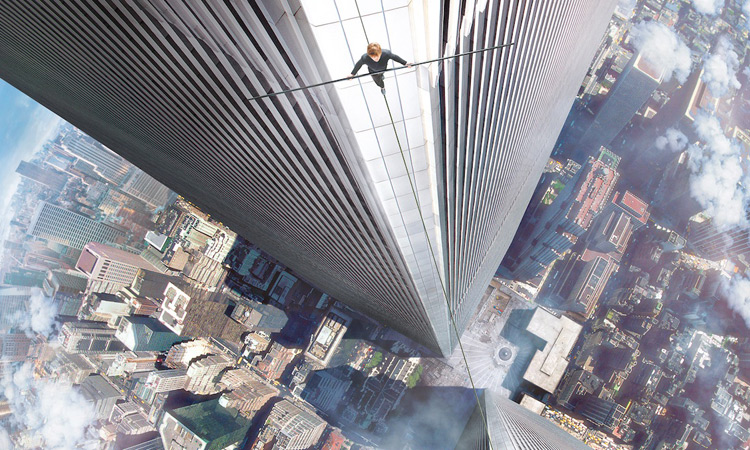The Walk, which relates the 1974 endeavor of the French artist Philippe Petit to travel between the twin towers of the World Trade Center on a tightrope, is a film of enormous scale and delicious playfulness. See it on the biggest screen possible, and you may briefly re-experience the wonder of what it’s like to see the world as a child: where skyscrapers are giant, adults are gods, and dreams are real.
It’s not a perfect film—for one thing, the dialogue is too often determined to tell us what the characters are thinking, rather than showing us their awe. Its digital effects also are sometimes breathtaking, but production technologies have not yet fully transcended the somewhat ‘plastic’ look this gives human faces and bodies framed against computer-generated light; and the in-picture narration seems more like filler than a service to the story. The 2008 Oscar-winning documentary Man on Wire tells the same tale with far more depth and detail, though it can’t compete with the visual spectacle of the new film.
But The Walk does have heart, a lovely central performance from Joseph Gordon-Levitt, and the story it is telling is so romantic and unique that it cannot fail to inspire. For Petit, fear of heights is a variation on fear of life itself; when he first saw an article about the building of the towers, it was as if they had been erected purely so that he could make them into art. He had to make this journey, to sketch into thin air the marvel of being human.
It took rare discipline—one witness to his preparations for this “coup” (to call it a “stunt” would be to miss its glory) described as “an ageless mask of concentration”. The holiness of working so hard at his vocation is the behind-the-scenes partner of how Petit inhabits the archetype of the jester or magician—the person who playfully shows us both our absurdity and our possibility.
His walk took place as the Watergate scandal was engulfing President Nixon, cynicism taking another step toward ruling public conversation. That was ugly enough, but no one, of course, guessed what would eventually happen to the World Trade Center. But over forty years later, the image of Philippe Petit inscribing his own magnificence in the sky does something remarkable. It takes something we think we know, that has become a source of fear and sadness, and turns them into an icon of the hope that human beings can do better than shopping or invading. They can co-create miracles.
He knew (and knows) that it is beauty that will save the world. The purpose of a day is to recover from our wounds by making something beautiful. A conversation, a meal, a piece of writing, an arrangement of flowers or furniture, an act of social courage, or just going for a walk. In Man on Wire, one of Petit’s cohorts speaks of his ‘coups’ as opportunities “to do something beautiful that not only doesn’t hurt anybody, but gives something to somebody.” Petit’s walk between the towers is, of course, radically different to the one I’ll take today by the river near my home, but both walks are an act of resistance to the pain of the world, and a gift to others.
Going for a walk, in the sky or by a river, transcends the pressure in our culture of separation to be always working, or running, or checking Facebook. Going for a walk, just for the sake of going for a walk, honors nature, reconnects us to the earth, heals our bodies, rejuvenates our minds. In refusing the fear of death imposed by a culture of accumulation, going for a walk says yes to life. In these days of spiritual opening-up, many people understandably quote Mary Oliver’s question, “Tell me, what is it you plan to do with your one wild and precious life?”
The man on the wire takes this a step further: what would it be “to die in the exercise of your passion?” When Philippe Petit lay down on his back, 1,312 feet above the standardized concrete sidewalks and diverse humanity of New York City, he was looking up. Getting into his true comfort zone, being consumed by his vision of beauty, healing himself, redeeming a space that didn’t even exist before he imagined it.
To find out about Rose’s thoughts on how to live a happier life, click here



